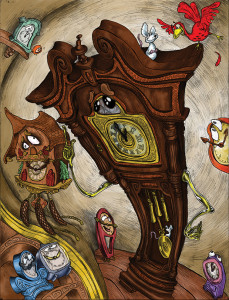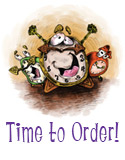Roman numerals and Arabic numerals on the clock faces
1. Some clocks have Roman numerals (I, II, III, IV or IIII, V, VI, VII, VIII, IX, XI, XII) and other clocks have Arabic numerals (1, 2, 3, 4, 5, 6, 7, 8, 9, 10, 11, 12). Point to some clocks with Roman numerals . Point to some clocks with Arabic numerals.
2. Some clocks show 4 as Roman numeral IIII (for example, the cuckoo clock)and other clocks show 4 as Roman numeral IV (for example, the clock on the high wire). The real Big Ben in London shows 4 as Roman numeral IV, but it is hard to see in the story illustrations. Many fascinating reasons have been suggested as to why IIII is sometimes used instead of IV on clocks. This would be an interesting subject to research. Maybe start by looking up the following link; there’s a section at the end of this article about IIII on clocks: http://en.wikipedia.org/wiki/Roman_numerals
Telling time in the story
Before answering the questions below, consider the following questions: How do you know what time it is in the story? Does the music sometimes help? How?
- What time is it when the clock shop closes?
- What time is it when Red flies out of his clock house (“miniature chalet”)?
- What time is it when the mice and cuckoo play “Hickory Dickory Dock”?
- What time is it when Big Ben gongs the clocks back home?
- What time is it when Phineas returns to the clock shop in the morning?
- How many total hours does the story cover, counting from when Phineas closes the clock shop to when he returns in the morning?




